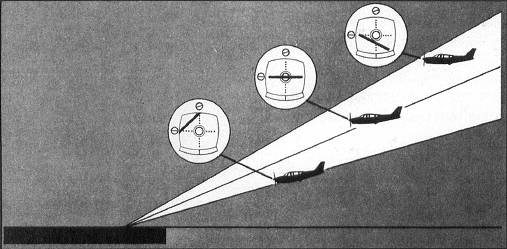

The coding identification of the outer locator consists of the first two letters of the three-letter identifier of the associated LOC. When used in conjunction with an ILS front course, the compass locator facilities are collocated with the outer and/or MM facilities. Compass locators are low-powered NDBs and are received and indicated by the ADF receiver. The back-course marker, where installed, indicates the back-course FAF. It indicates the point at which an aircraft is at the decision height on the glide path during a Category II ILS approach. The inner marker (IM), where installed, is located on the front course between the MM and the landing threshold.


The OM is located on the localizer front course 4 to 7 miles from the airport to indicate a position at which an aircraft, at the appropriate altitude on the localizer course, will intercept the glide path The MM is located approximately 3,500 feet from the landing threshold on the centerline of the localizer front course at a position where the glide-slope centerline is about 200 feet above the touchdown zone elevation.A marker beacon may also be installed to indicate the FAF on the ILS back course. A third beacon, the inner, is used where Category II operations are certified. Two VHF marker beacons, outer and middle, are normally used in the ILS system. At 10 NM from the point of touchdown, this represents a vertical distance of approximately 1,500 feet, narrowing to a few feet at touchdown. The system provides no vertical guidance for approaches on the back course. Unlike the localizer, the glide-slope transmitter radiates signals only in the direction of the final approach on the front course.At locations where standard minimum obstruction clearance cannot be obtained with the normal maximum glide-slope angle, the glide-slope equipment is displaced farther from the approach end of the runway if the length of the runway permits or, the glideslope angle may be increased up to 4°. The glide-slope projection angle is normally adjusted to 2.5° to 3.5° above horizontal, so it intersects the MM at about 200 feet and the OM at about 1,400 feet above the runway elevation. The course projected by the glide-slope equipment is essentially the same as would be generated by a localizer operating on its side.The glide-slope equipment is housed in a building approximately 750 to 1,250 feet down the runway from the approach end of the runway, and between 400 and 600 feet to one side of the centerline.The glide path is the straight, sloped line the aircraft should fly in its descent from where the glide slope intersects the altitude used for approaching the FAF, to the runway touchdown zone. Glide slope (GS) describes the systems that generate, receive, and indicate the ground facility radiation pattern. With no more than one-quarter scale deflection maintained, the aircraft will be aligned with the runway. This sensitivity permits accurate orientation to the landing runway. With this course width, a full-scale deflection shows when the aircraft is 2.5° to either side of the centerline. The localizer course is very narrow, normally 5°.The localizer provides course guidance, transmitted at 108.1 to 111.95 MHz (odd tenths only), throughout the descent path to the runway threshold from a distance of 18 NM from the antenna to an altitude of 4,500 feet above the elevation of the antenna site.

These are called the front and back courses, respectively. This unit radiates a field pattern, which develops a course down the centerline of the runway toward the middle markers (MMs) and outer markers (OMs), and a similar course along the runway centerline in the opposite direction. The localizer (LOC) ground antenna array is located on the extended centerline of the instrument runway of an airport, remote enough from the opposite (approach) end of the runway to prevent it from being a collision hazard.


 0 kommentar(er)
0 kommentar(er)
